Optimal Placement and Sizing of Electric Vehicle Charging Infrastructure in a Grid-Tied DC Microgrid Using Modified TLBO Method
Abstract
1. Introduction
- A new problem formulation is proposed for a grid-connected DC microgrid to optimize the cost and VRP index on modified IEEE 33- and 123-bus radial distribution units after installing EVCSs.
- The proposed case of operation is performed on a DC MG integrated with the utility grid for optimal position and sizing of EVCSs with RESs under six diverse schemes to minimize the VRP index and cost with the related constraints. The minimization of the VRP index and cost is compared with the latest published results.
- The VRP index is optimized to account for 24 h variations in PV, wind, and EV loads.
- The operation strategy is proposed to minimize the cost and VRP index by performing distribution load flow on a DC microgrid. The proposed operation strategy helps to improve the voltage profile by the optimal location of RESs and EVCSs on modified IEEE test systems.
- Modified meta-heuristic optimization technique TLBO given numerous relevant constraints with the proposed operation strategy is employed to resolve this composite problem.
- The investigation of modified TLBO for the proposed operation strategy produces solutions of improved quality, which is evident in the numerical outcomes.
2. Modeling DC MG Components
2.1. Solar PV
2.2. Wind Energy System
2.3. Fuel Cell
3. Problem Formulation
3.1. Objective Function and Related Constraints
3.1.1. Cost
3.1.2. VRP (Voltage Stability, Reliability, Power Loss) Index
3.2. Proposed Operational Strategy
- Step 1:
- Identify the preliminary value i = 1.
- Step 2:
- Select the modified IEEE 33- and 123-bus system for the analysis of the VRP index.
- Step 3:
- Figure out the value of wind, PV, and fuel cell output power using (1) to (4).
- Step 4:
- Run the load flow for the base case by the forward-backward technique.
- Step 5:
- Estimate the voltage sensitivity factor (VSF) for all buses using (44) [38].VSF = |dv/dp|
- Step 6:
- Based on the VSF, the CS is optimally selected. Increase the charging station load in phases.
- Step 7:
- Run distribution load flow analysis by the forward-backward method.
- Step 8:
- Optimize the VRP index and cost.
- Step 9:
- The wind, PV, and fuel cell output power is integrated into the modified IEEE 33- as well as 123-bus system and the EVCS load.
- Step 10:
- Run a forward-backward load flow method.
- Step 11:
- To minimize the VRP index further, the location and sizing of RESs are optimally selected.
4. Optimization Algorithm Based on Modified Teaching-Learning Method
5. Results and Discussion
5.1. Cost Objective Function
5.2. VRP Index
5.2.1. IEEE 33-Bus System
5.2.2. IEEE 123-Bus System
6. Conclusions
Author Contributions
Funding
Data Availability Statement
Conflicts of Interest
References
- Fang, S.; Zhao, T.; Xu, Y.; Lu, T. Coordinated Chance-constrained Optimization of Multi-energy Microgrid System for Balancing Operation Efficiency and Quality-of-service. J. Mod. Power Syst. Clean Energy 2020, 8, 853–862. [Google Scholar] [CrossRef]
- Salkuti, S.R. Short-term optimal hydro-thermal scheduling using clustered adaptive teaching learning based optimization. Int. J. Electr. Comput. Eng. 2019, 9, 3359. [Google Scholar] [CrossRef]
- Aluisio, B.; Bruno, S.; De Bellis, L.; Dicorato, M.; Forte, G.; Trovato, M. DC-Microgrid Operation Planning for an Electric Vehicle Supply Infrastructure. Appl. Sci. 2019, 9, 2687. [Google Scholar] [CrossRef]
- Pagidipala, S.; Vuddanti, S. Solving realistic reactive power market clearing problem of wind-thermal power system with system security. Int. J. Emerg. Electr. Power Syst. 2021, 23, 125–144. [Google Scholar] [CrossRef]
- Deb, S.; Tammi, K.; Kalita, K.; Mahanta, P. Charging Station Placement for Electric Vehicles: A Case Study of Guwahati City, India. IEEE Access 2019, 7, 100270–100282. [Google Scholar] [CrossRef]
- Mozafar, M.R.; Moradi, M.H.; Amini, M.H. A simultaneous approach for optimal allocation of renewable energy sources and electric vehicle charging stations in smart grids based on improved GA-PSO algorithm. Sustain. Cities Soc. 2017, 32, 627–637. [Google Scholar] [CrossRef]
- Bilal, M.; Rizwan, M.; Alsaidan, I.; Almasoudi, F.M. AI-Based Approach for Optimal Placement of EVCS and DG With Reliability Analysis. IEEE Access 2021, 9, 154204–154224. [Google Scholar] [CrossRef]
- Dhingra, K.; Singh, M. Smart Charging Station to Cater the Sudden Ingress and Egress of EVs while Supporting the Frequency of Microgrid through VSG. Arab. J. Sci. Eng. 2020, 45, 6715–6727. [Google Scholar] [CrossRef]
- Deb, S.; Tammi, K.; Kalita, K.; Mahanta, P. Impact of electric vehicle charging station load on distribution network. Energies 2018, 11, 178. [Google Scholar] [CrossRef]
- Awasthi, A.; Venkitusamy, K.; Padmanaban, S.; Selvamuthukumaran, R.; Blaabjerg, F.; Singh, A.K. Optimal planning of electric vehicle charging station at the distribution system using hybrid optimization algorithm. Energy 2017, 133, 70–78. [Google Scholar] [CrossRef]
- Cui, Q.; Weng, Y.; Tan, C.-W. Electric Vehicle Charging Station Placement Method for Urban Areas. IEEE Trans. Smart Grid 2019, 10, 6552–6565. [Google Scholar] [CrossRef]
- Jawad, S.; Liu, J. Electrical Vehicle Charging Services Planning and Operation with Interdependent Power Networks and Transportation Networks: A Review of the Current Scenario and Future Trends. Energies 2020, 13, 3371. [Google Scholar] [CrossRef]
- Wang, D.; Locment, F.; Sechilariu, M. Modelling, Simulation, and Management Strategy of an Electric Vehicle Charging Station Based on a DC Microgrid. Appl. Sci. 2020, 10, 2053. [Google Scholar] [CrossRef]
- AbuElrub, A.; Hamed, F.; Saadeh, O. Microgrid integrated electric vehicle charging algorithm with photovoltaic generation. J. Energy Storage 2020, 32, 101858. [Google Scholar] [CrossRef]
- Khaksari, A.; Tsaousoglou, G.; Makris, P.; Steriotis, K.; Efthymiopoulos, N.; Varvarigos, E. Sizing of electric vehicle charging stations with smart charging capabilities and quality of service requirements. Sustain. Cities Soc. 2021, 70, 102872. [Google Scholar] [CrossRef]
- Deb, S.; Tammi, K.; Gao, X.-Z.; Kalita, K.; Mahanta, P.; Cross, S. A Robust Two-Stage Planning Model for the Charging Station Placement Problem Considering Road Traffic Uncertainty. IEEE Trans. Intell. Transp. Syst. 2021, 23, 6571–6585. [Google Scholar] [CrossRef]
- Pal, A.; Bhattacharya, A.; Chakraborty, A.K. Allocation of EV Public Charging Station in Renewable based Distribution Network using HHO Considering Uncertainties and Traffic Congestion. Res. Sq. 2021. preprint. [Google Scholar]
- Islam, M.; Shareef, H.; Mohamed, A. Improved approach for electric vehicle rapid charging station placement and sizing using Google maps and binary lightning search algorithm. PLoS ONE 2017, 12, e0189170. [Google Scholar] [CrossRef]
- Bhadra, J.; Chattopadhyay, T.K. Analysis of distribution network by reliability indices. In Proceedings of the 2015 International Conference on Energy, Power and Environment: Towards Sustainable Growth (ICEPE), Shillong, India, 12–13 June 2015; pp. 1–5. [Google Scholar]
- Jadoun, V.K.; Sharma, N.; Jha, P.; Malik, H.; Garcia Márquez, F.P. Optimal scheduling of dynamic pricing based v2g and g2v operation in microgrid using improved elephant herding optimization. Sustainability 2021, 13, 7551. [Google Scholar] [CrossRef]
- Aluisio, B.; Dicorato, M.; Ferrini, I.; Forte, G.; Sbrizzai, R.; Trovato, M. Optimal Sizing Procedure for Electric Vehicle Supply Infrastructure Based on DC Microgrid with Station Commitment. Energies 2019, 12, 1901. [Google Scholar] [CrossRef]
- Navin, N.K. A Multiagent Fuzzy Reinforcement Learning Approach for Economic Power Dispatch Considering Multiple Plug-In Electric Vehicle Loads. Arab. J. Sci. Eng. 2021, 46, 1431–1449. [Google Scholar] [CrossRef]
- Suresh, V.; Bazmohammadi, N.; Janik, P.; Guerrero, J.M.; Kaczorowska, D.; Rezmer, J.; Jasinski, M.; Leonowicz, Z. Optimal location of an electrical vehicle charging station in a local microgrid using an embedded hybrid optimizer. Int. J. Electr. Power Energy Syst. 2021, 131, 106979. [Google Scholar] [CrossRef]
- Chen, L.; Xu, C.; Song, H.; Jermsittiparsert, K. Optimal sizing and sitting of EVCS in the distribution system using metaheuristics: A case study. Energy Rep. 2021, 7, 208–217. [Google Scholar] [CrossRef]
- Ali, A.; Mahmoud, K.; Lehtonen, M. Optimal planning of inverter-based renewable energy sources towards autonomous microgrids accommodating electric vehicle charging stations. IET Gener. Transm. Distrib. 2022, 16, 219–232. [Google Scholar] [CrossRef]
- Archana, A.N.; Rajeev, T. A Novel Reliability Index Based Approach for EV Charging Station Allocation in Distribution System. IEEE Trans. Ind. Appl. 2021, 57, 6385–6394. [Google Scholar] [CrossRef]
- Shaker, M.H.; Farzin, H.; Mashhour, E. Joint planning of electric vehicle battery swapping stations and distribution grid with centralized charging. J. Energy Storage 2023, 58, 106455. [Google Scholar] [CrossRef]
- Wang, S.; Lu, L.; Han, X.; Ouyang, M.; Feng, X. Virtual-battery based droop control and energy storage system size optimization of a DC microgrid for electric vehicle fast charging station. Appl. Energy 2020, 259, 114146. [Google Scholar] [CrossRef]
- Vinod, K.R.; Singh, S. Solar photovoltaic modeling and simulation: As a renewable energy solution. Energy Rep. 2018, 4, 701–712. [Google Scholar] [CrossRef]
- Shaikh, M.R.S. A Review Paper on Electricity Generation from Solar Energy. Int. J. Res. Appl. Sci. Eng. Technol. 2017, 5, 1884–1889. [Google Scholar] [CrossRef]
- Chedid, R.; Sawwas, A. Optimal placement and sizing of photovoltaics and battery storage in distribution networks. Energy Storage 2019, 1, e46. [Google Scholar] [CrossRef]
- Pandey, A.K.; Jadoun, V.K.; Sabhahit, J.N. Real-Time Peak Valley Pricing Based Multi-Objective Optimal Scheduling of a Virtual Power Plant Considering Renewable Resources. Energies 2022, 15, 5970. [Google Scholar] [CrossRef]
- Djelailia, O.; Kelaiaia, M.S.; Labar, H.; Necaibia, S.; Merad, F. Energy hybridization photovolta-ic/diesel generator/pump storage hydroelectric management based on online optimal fuel consumption per kWh. Sustain. Cities Soc. 2019, 44, 1–15. [Google Scholar] [CrossRef]
- Slootweg, J.G.; de Haan, S.W.H.; Polinder, H.; Kling, W.L. General model for representing variable speed wind turbines in power system dynamics simulations. IEEE Trans. Power Syst. 2003, 18, 144–151. [Google Scholar] [CrossRef]
- Verde, A.; Lastres, O.; Hernández, G.; Ibañez, G.; Verea, L.; Sebastian, P.J. A new method for characterization of small capacity wind turbines with permanent magnet synchronous generator: An experimental study. Heliyon 2018, 4, e00732. [Google Scholar] [CrossRef]
- Wang, C.-N.; Lin, W.-C.; Le, X.-K. Modelling of a PMSG Wind Turbine with Autonomous Control. Math. Probl. Eng. 2014, 2014, 856173. [Google Scholar] [CrossRef]
- Jayalakshmi, N.S.; Gaonkar, D.N. Operation of grid integrated wind/PV hybrid system with grid perturbations. Int. J. Renew. Energy Res. 2015, 5, 1106–1111. [Google Scholar]
- Omran, A.; Lucchesi, A.; Smith, D.; Alaswad, A.; Amiri, A.; Wilberforce, T.; Sodré, J.R.; Olabi, A. Mathematical model of a proton-exchange membrane (PEM) fuel cell. Int. J. Thermofluids 2021, 11, 100110. [Google Scholar] [CrossRef]
- Hailu Kebede, M.; Bekele Beyene, G. Feasibility study of PV-wind-fuel cell hybrid power system for electrification of a rural village in Ethiopia. J. Electr. Comput. Eng. 2018, 2018, 4015354. [Google Scholar] [CrossRef]
- Rahman, M.M.; Barua, S.; Zohora, S.T.; Hasan, K.; Aziz, T. Voltage sensitivity based site selection for PHEV charging station in commercial distribution system. In Proceedings of the 2013 IEEE PES Asia-Pacific Power and Energy Engineering Conference (APPEEC), Hong Kong, China, 8–11 December 2013; pp. 1–6. [Google Scholar] [CrossRef]
- Rao, R.V.; Savsani, V.J.; Vakharia, D.P. Teaching–learning-based optimization: A novel method for constrained mechanical design optimization problems. Comput. Aided Des. 2011, 43, 303–315. [Google Scholar] [CrossRef]
- Rao, R. Review of applications of TLBO algorithm and a tutorial for beginners to solve the unconstrained and constrained optimization problems. Decis. Sci. Lett. 2016, 5, 1–30. [Google Scholar]
- Tahmasebi, M.; Pasupuleti, J.; Mohamadian, F.; Shakeri, M.; Guerrero, J.; Khan, M.B.; Nazir, M.; Safari, A.; Bazmohammadi, N. Optimal Operation of Stand-Alone Microgrid Considering Emission Issues and Demand Response Program Using Whale Optimization Algorithm. Sustainability 2021, 13, 7710. [Google Scholar] [CrossRef]
- Feeders, D.T. IEEE PES Distribution System Analysis Subcommittee. 2011. Available online: http://sites.ieee.org/pes-testfeeders (accessed on 22 August 2022).
- Jiang, Z.; Zou, F.; Chen, D.; Kang, J. An improved teaching–learning-based optimization for multilevel thresholding image segmentation. Arab. J. Sci. Eng. 2021, 46, 8371–8396. [Google Scholar] [CrossRef]
- Zou, F.; Chen, D.; Wang, J. An Improved Teaching-Learning-Based Optimization with the Social Character of PSO for Global Optimization. Comput. Intell. Neurosci. 2016, 2016, 18. [Google Scholar] [CrossRef] [PubMed]
- The Annual Variability of Wind Speed. Available online: https://www.wind-energy-the-facts.org/the-annual-variability-of-wind-speed.html (accessed on 22 August 2022).
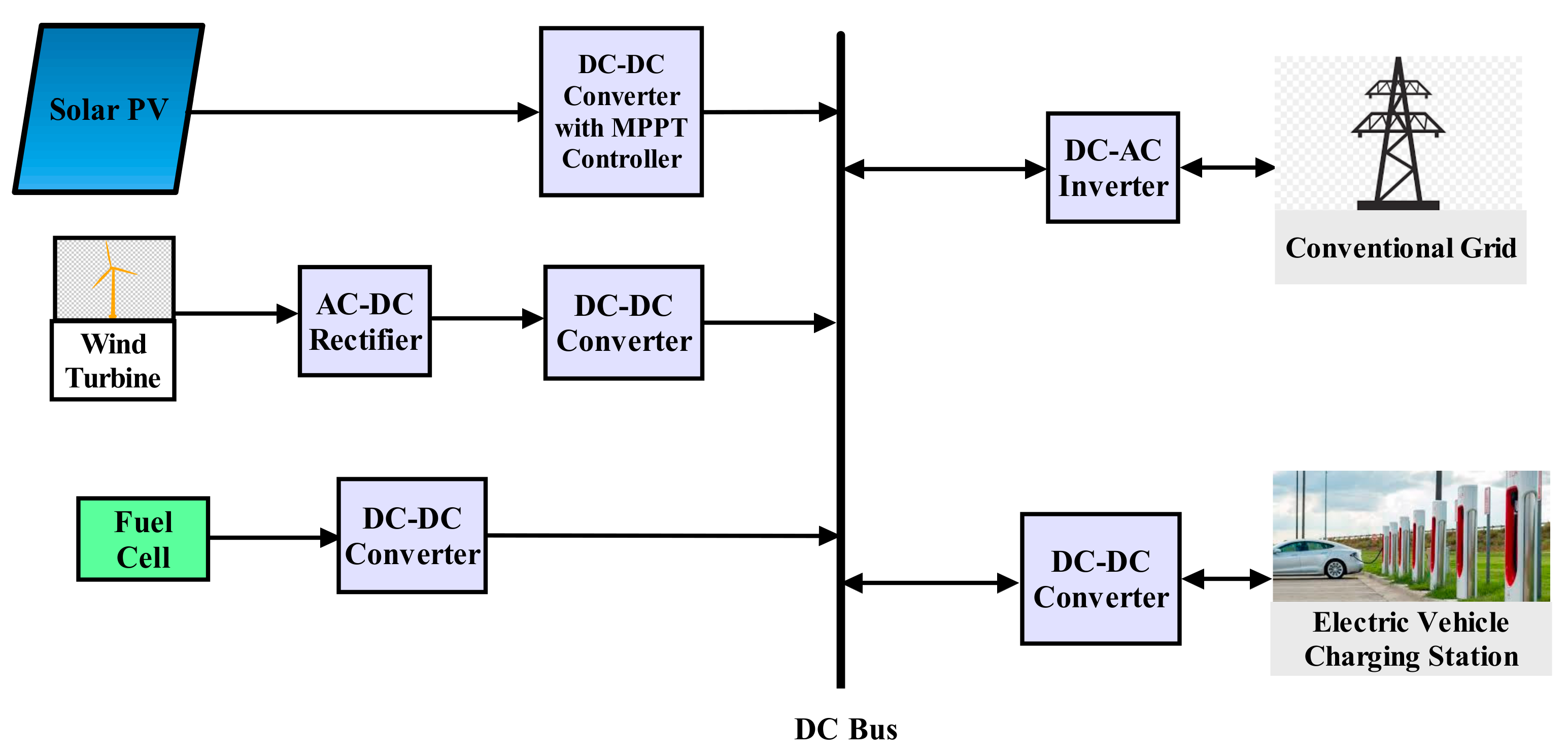


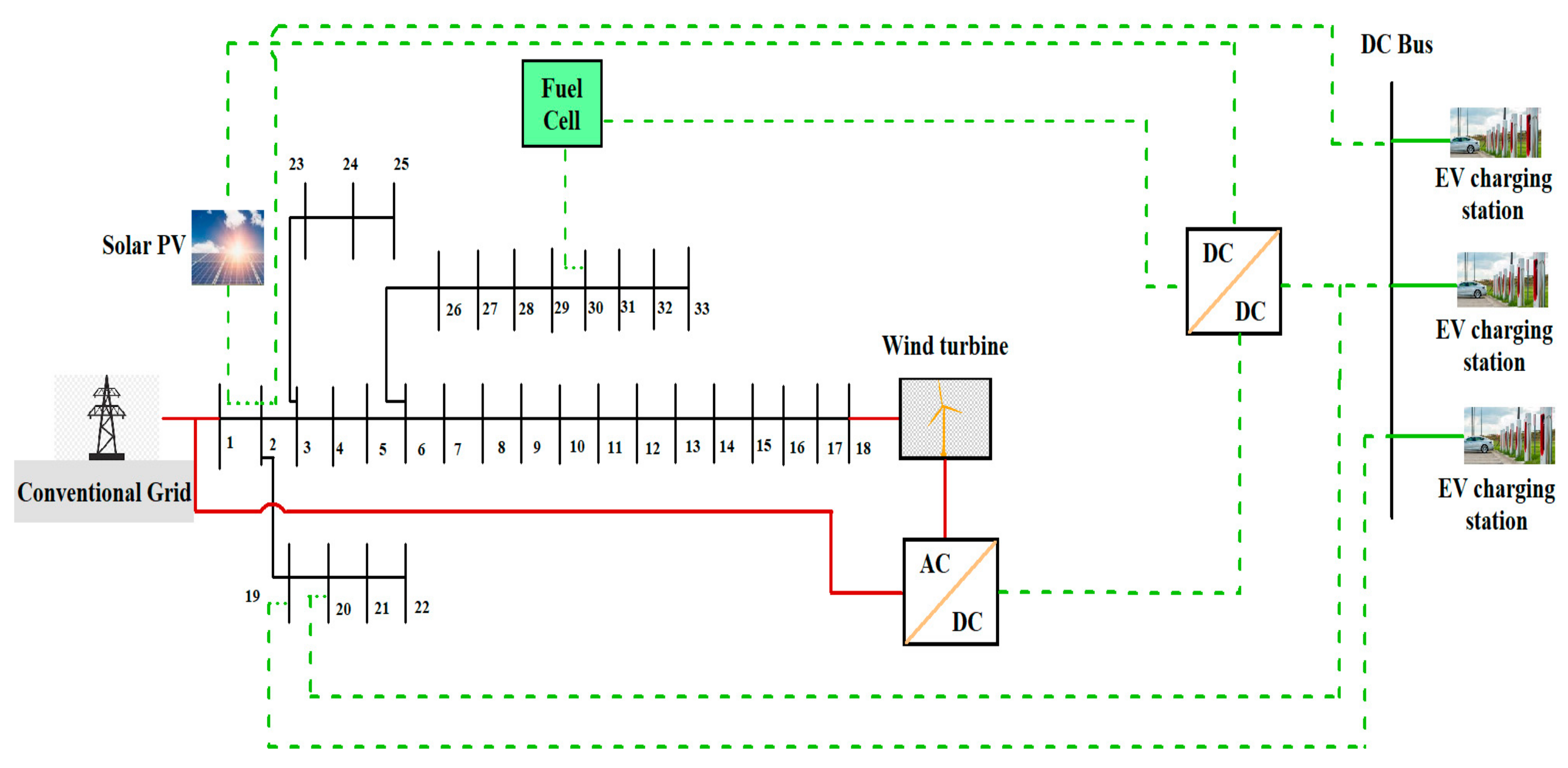

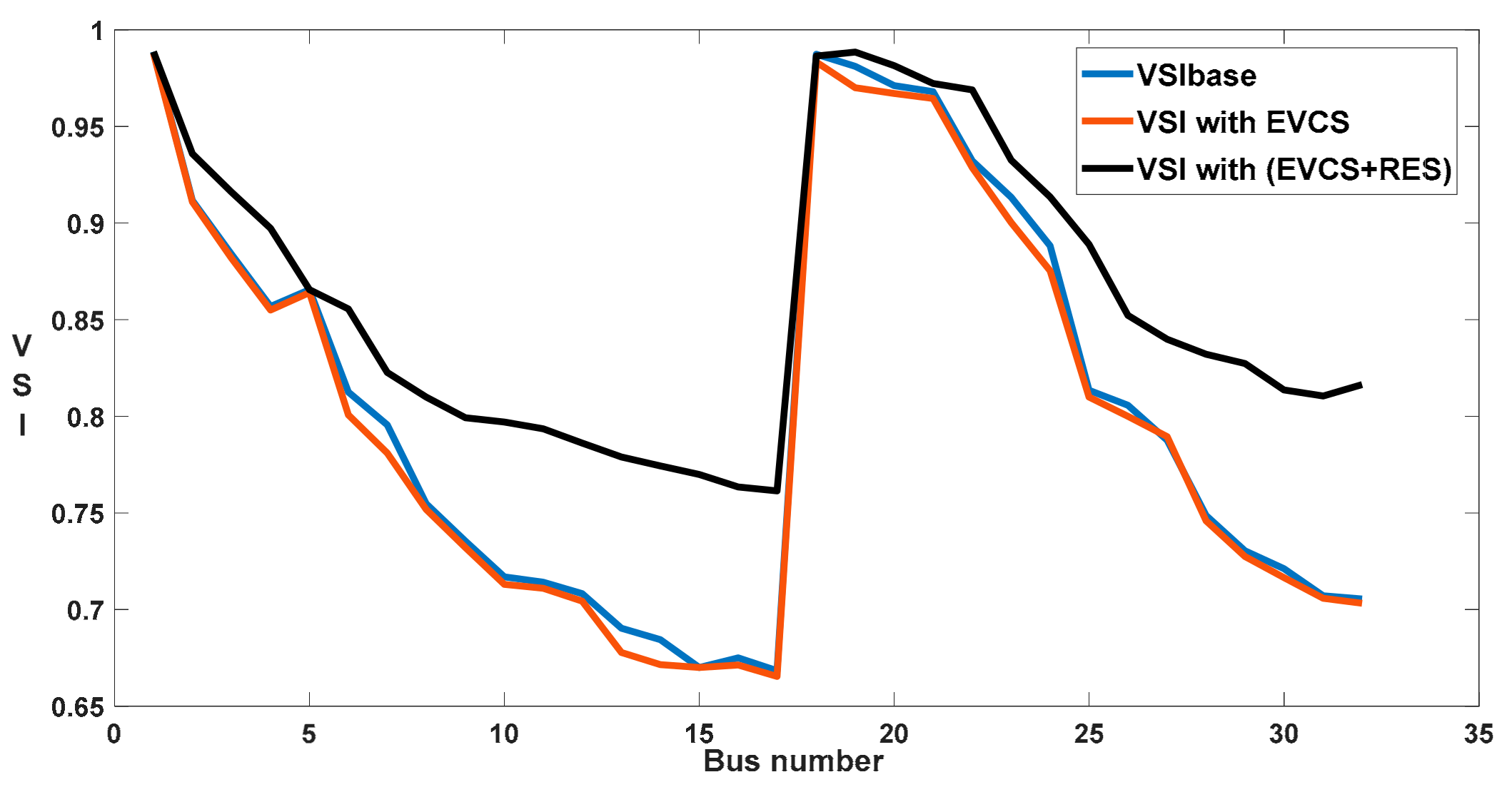

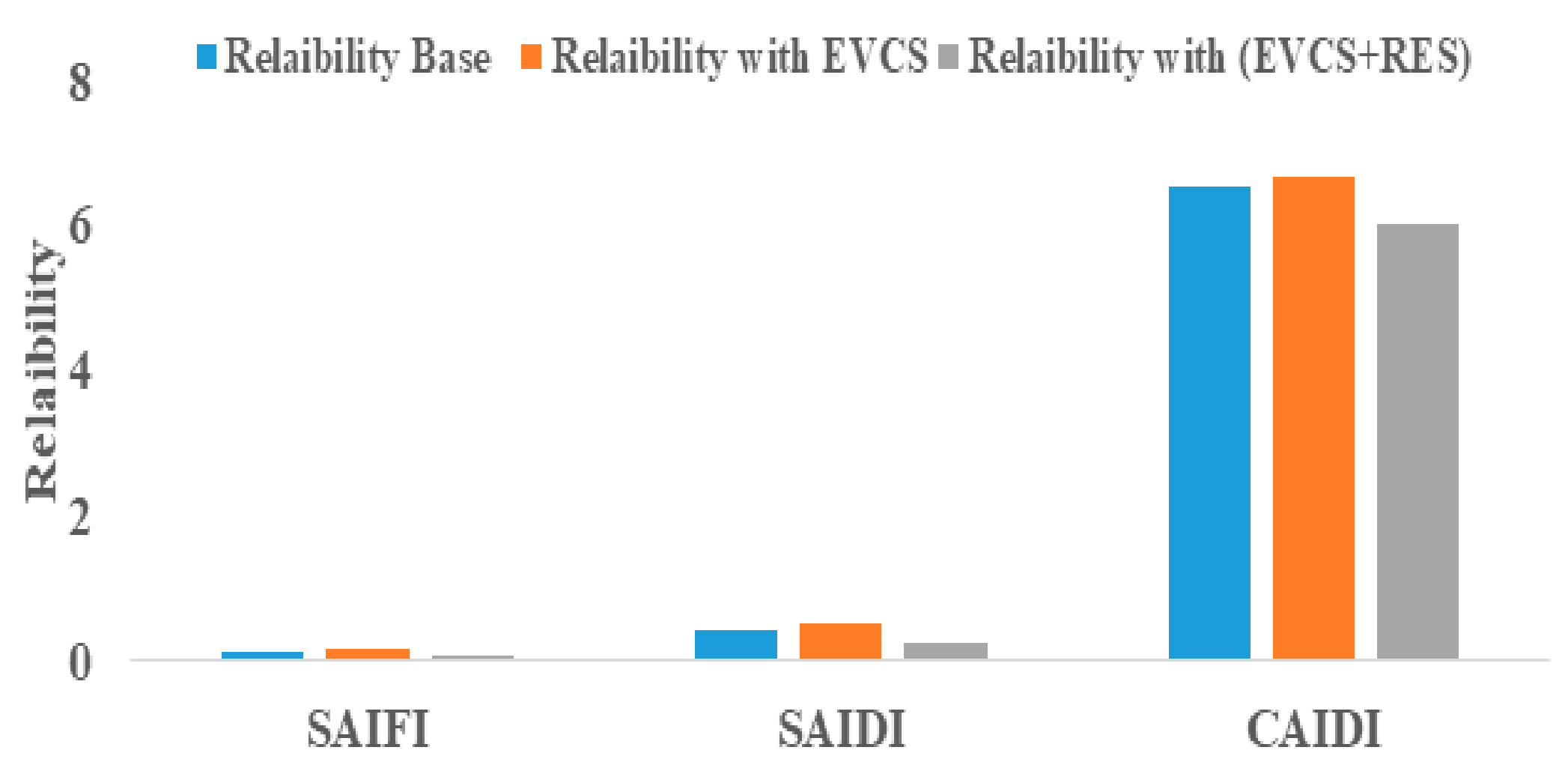
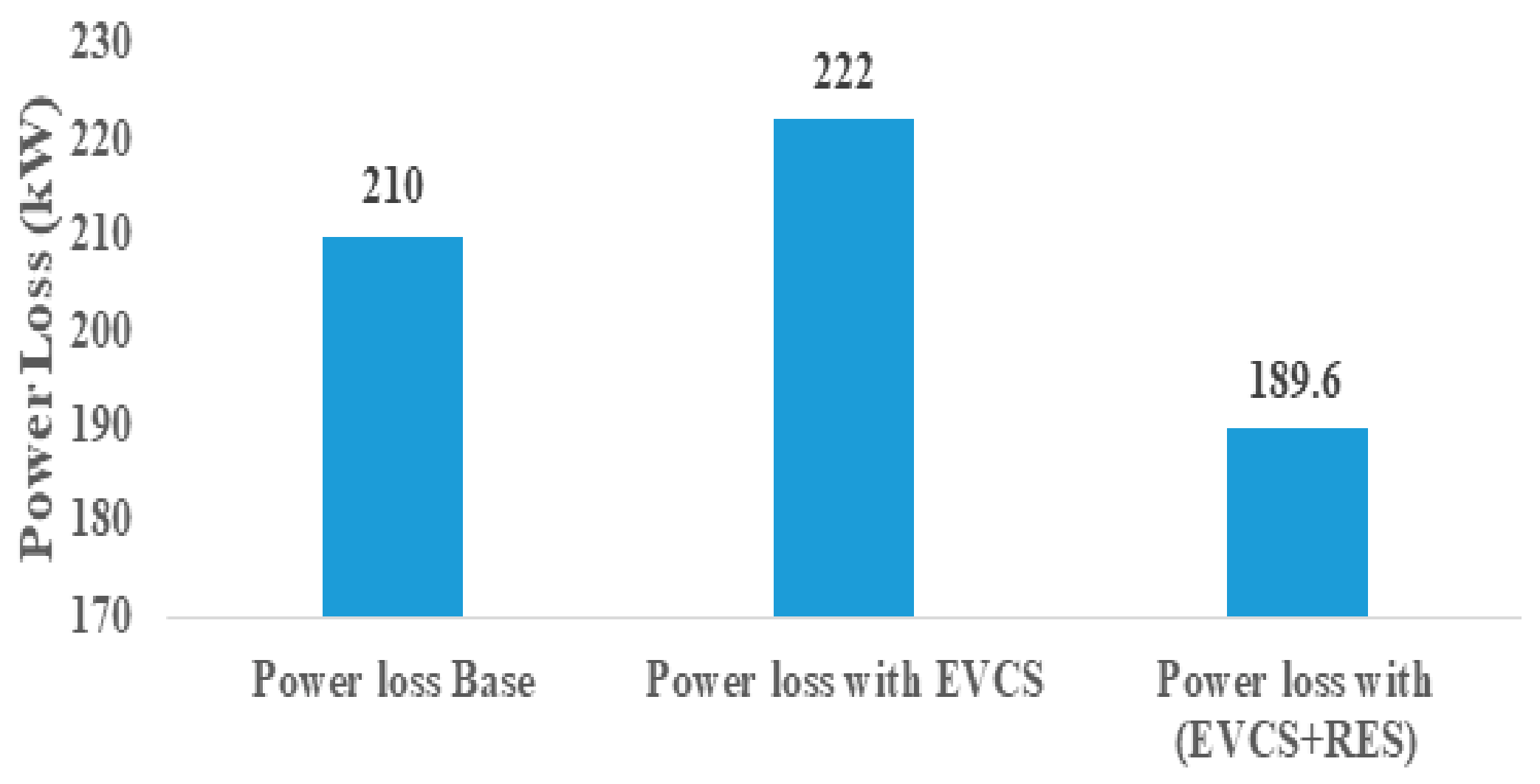
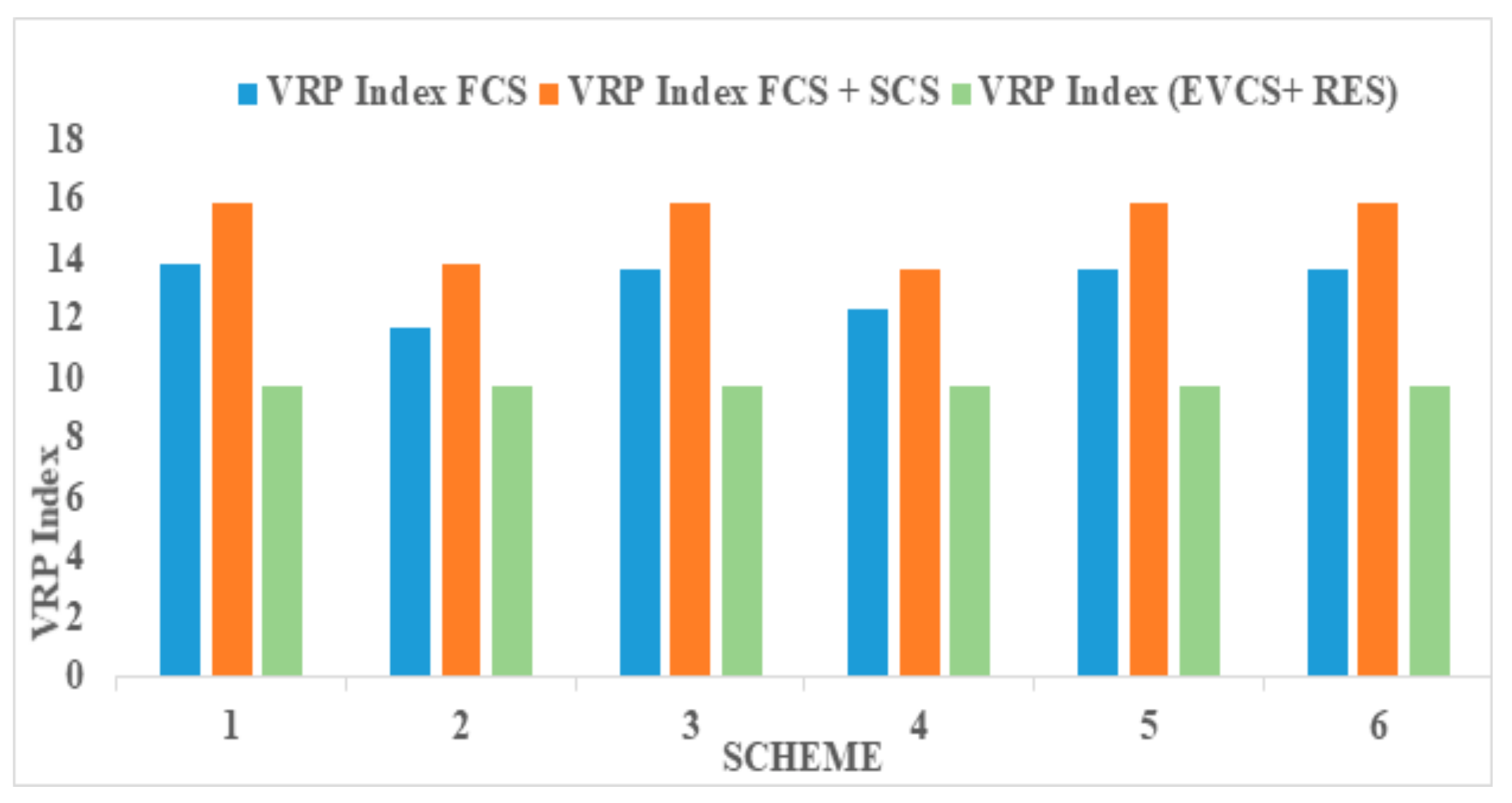


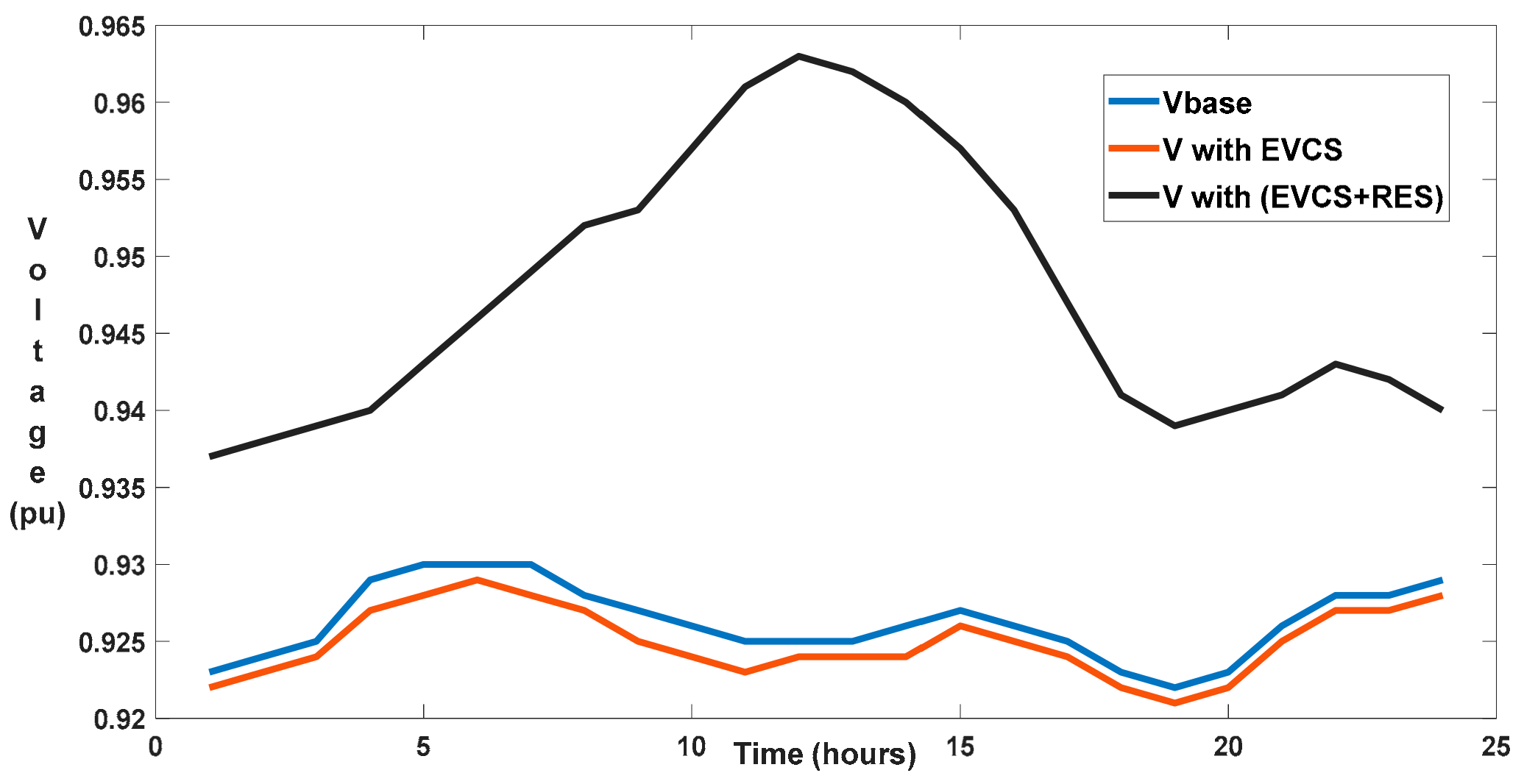
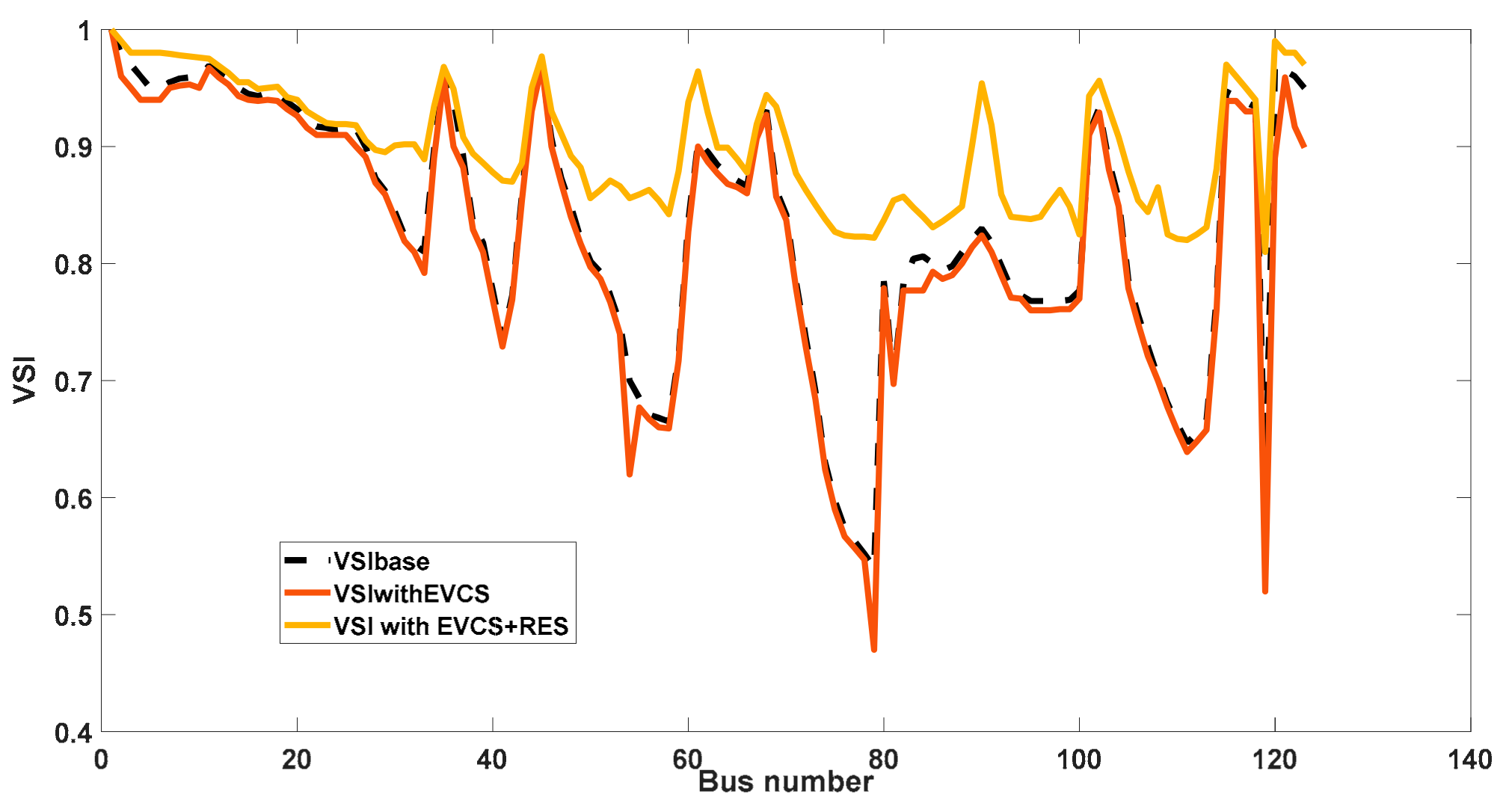
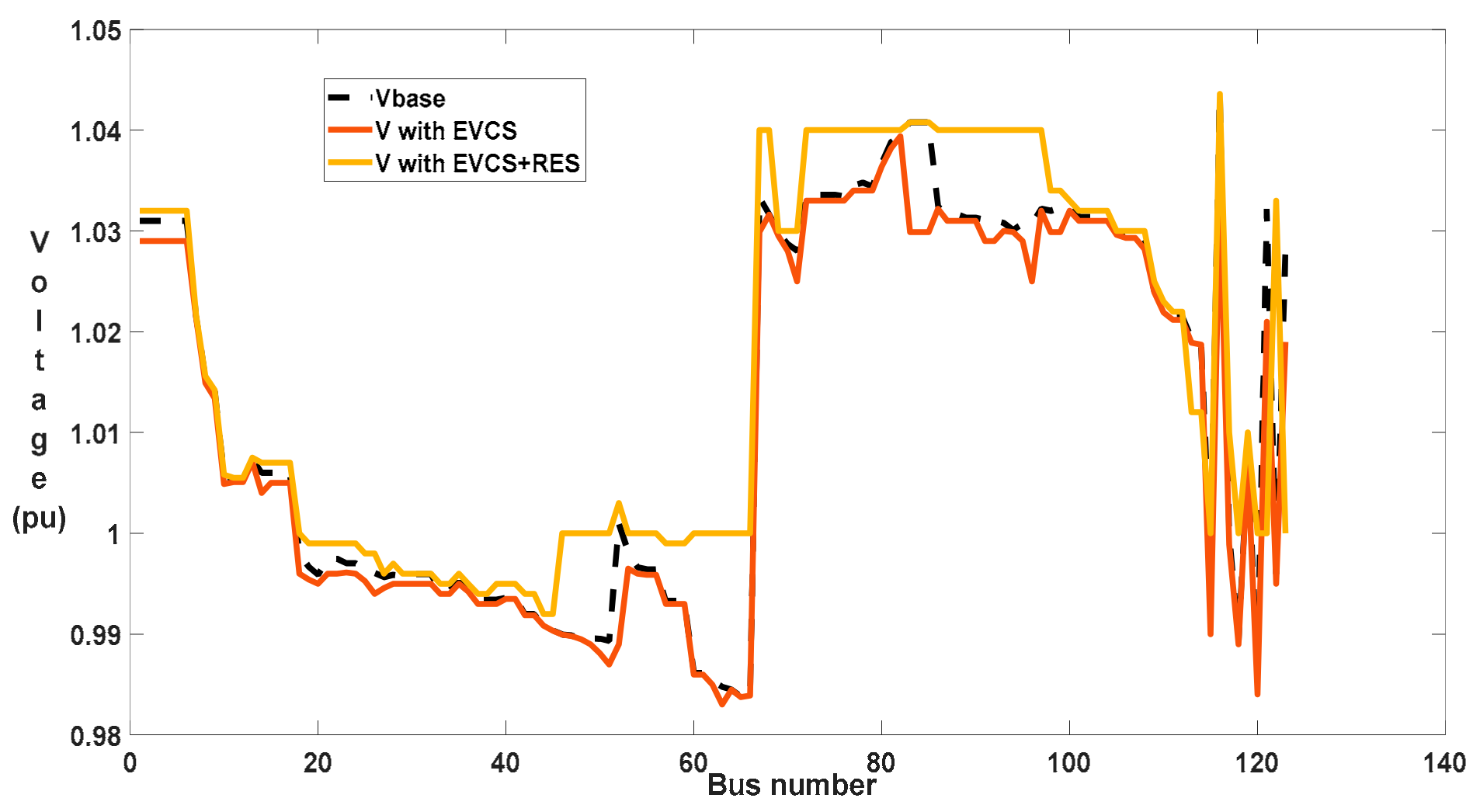



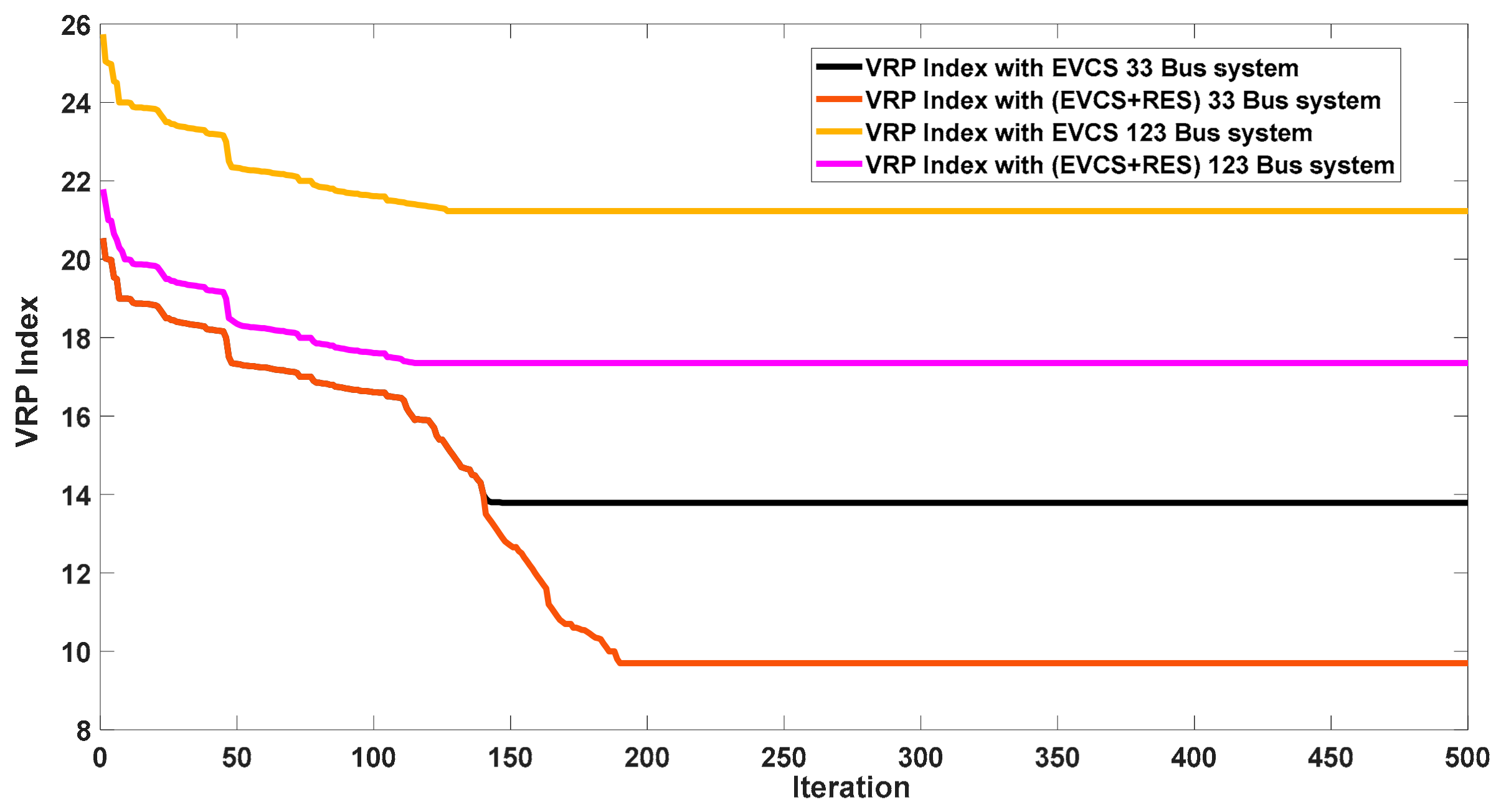
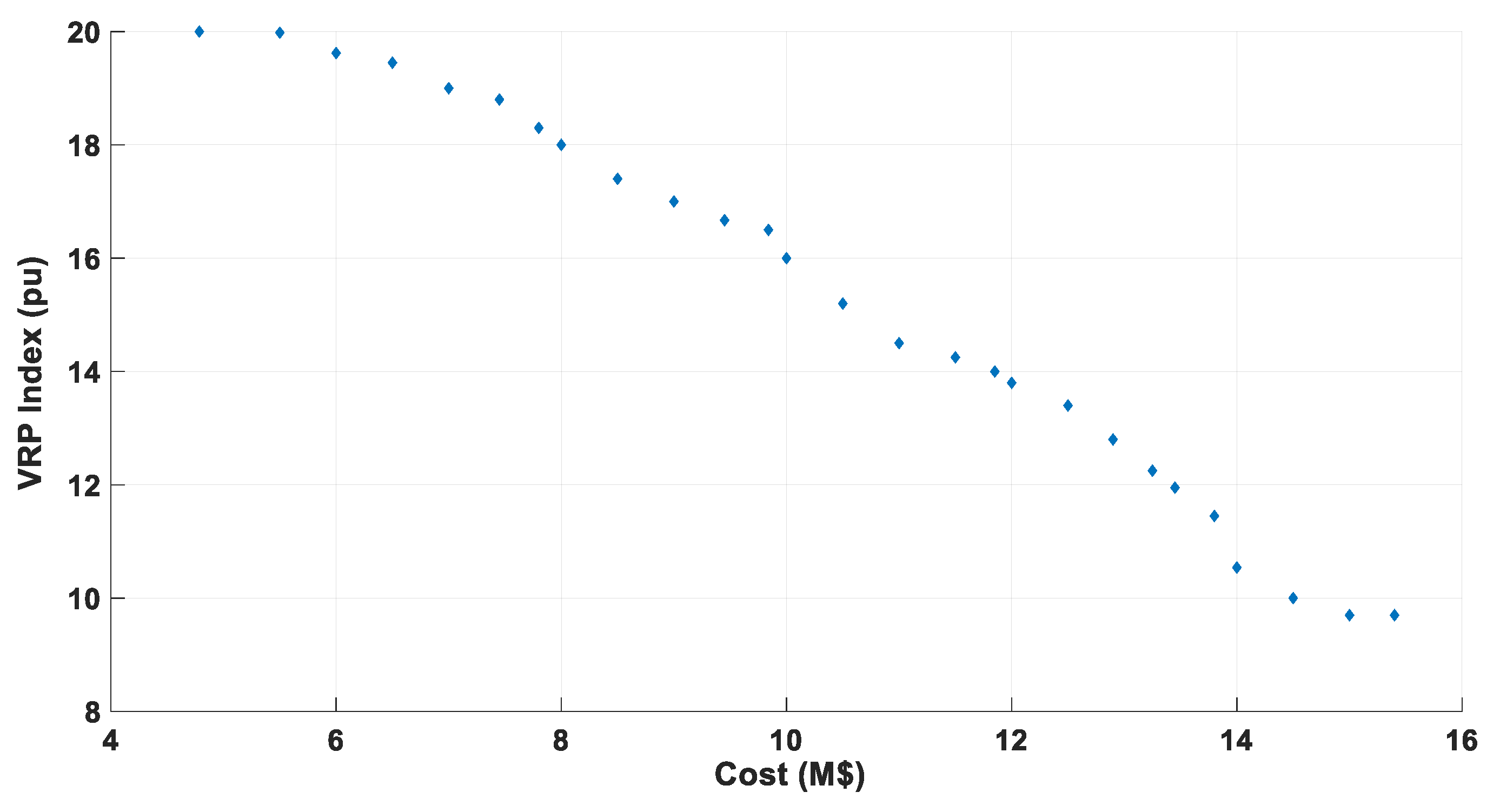
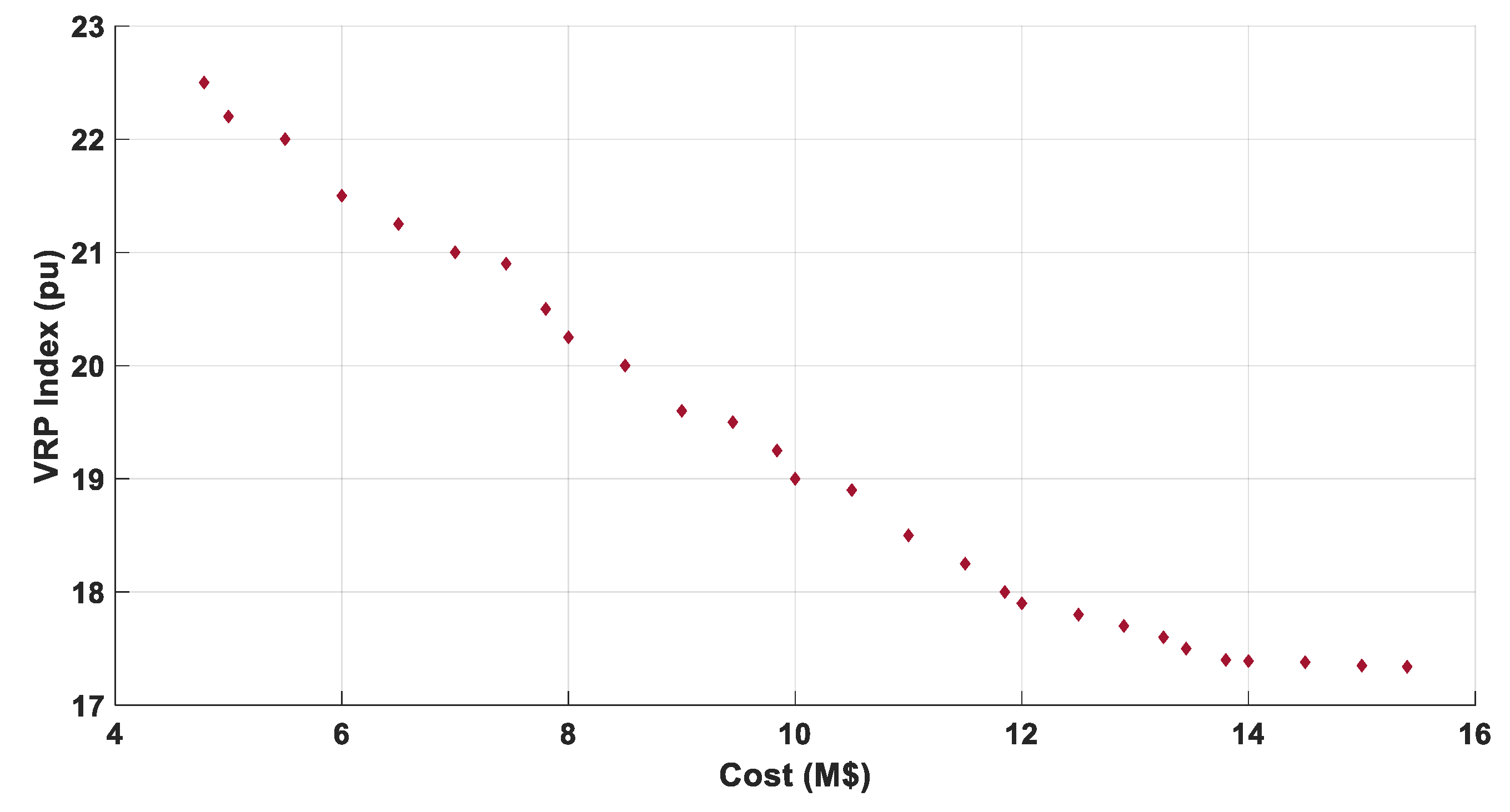
| Reference Number | Technique Applied | Remarks |
|---|---|---|
| [3] | CSO-TLBO | Considering voltage stability, reliability, power loss, the availability of charging stations, and the waiting time within the charging station as functional constraints, EVCS is positioned optimally. |
| [4] | GA-PSO | Optimal placing and sizing of RESs and EVCSs are performed on IEEE 33 test system to decrease power losses, voltage variations, and EV storage price. |
| [5] | GWO-PSO | The placement of EVCSs and DGs on IEEE 33- and 69-bus systems is performed to verify the reliability of the distribution network. |
| [7] | GA | The placement of EVCSs has been implemented on IEEE 33-bus system to optimize the VRP index of the distribution system. |
| [8] | GA-PSO | The installation of EVCSs in the Allahabad distribution unit is performed considering protective device upgrade cost. |
| [13] | Monte Carlo Simulations (MCS) | Charging station (CS) sizing is performed with smart charging competencies during operation to lessen the investment cost of charging station operators. |
| [14] | CSO-TLBO | The CS placement problem is solved by considering the VRP index, cost, waiting time, and accessibility index as objective functions. Two-stage planning exemplar is authenticated on IEEE 33-bus system and practical network in Tianjin, China. |
| [15] | Harris Hawk Optimization (HHO) | The CS and solar-based DG placement is performed on 33-bus systems to reduce losses with energy and improvement of the voltage profile. |
| [18] | GWO | The effect of EV placement on the 69-bus test system has been analyzed to enhance the voltage profile and minimize power losses. |
| [19] | Scenario based operation | Techno-economic sizing of a DC MG is performed, and EV commitment is developed. |
| Present paper | Modified TLBO | Optimal placement and sizing of EVCSs and RESs are performed simultaneously to optimize the cost and VRP index on IEEE 33- and 123-bus test units in a DC MG environment. |
| Author | Approach | Objective Function |
|---|---|---|
| Hu et al. (2013) | Single-objective | Cost is optimized focusing solely on the distribution unit. |
| Zheng et al. (2014) | Single-objective | Cost is optimized focusing solely on the distribution unit. |
| Pazouki et al. (2015) | Multi-objective | Cost, power loss, and voltage profile are optimized on distribution unit. |
| Marcelo et al. (2015) | Multi-objective | Active power loss optimization considering distribution network. |
| Pan et al. (2016) | Multi-objective | Cost and momentary power supply index are optimized on distribution network. |
| Aljanad et al. (2018) | Multi-objective | Voltage deviation and power loss considering distribution network. |
| Zhang et al. (2018) | Multi-objective | Charging station construction cost, discontented charging demand penalty, and cost of energy considering both distribution and transportation network. |
| Rahmani Andebili et al. (2018) | Multi-objective | Cost, power loss, and unmet energy expectations considering both distribution and transportation network. |
| S. Deb et al. (2019) | Multi-objective | Cost, accessibility index, VRP index, and wait time considering both distribution and transportation network. |
| Sachan, Sulabh et al. (2021) | Multi-objective | Cost and VRP index with coordinated and uncoordinated charging considering both distribution and transportation network. |
| Reference No. | Type of Optimization Algorithm | Feature of Optimization Algorithm |
|---|---|---|
| [4] | CSO—TLBO | Bio-inspired algorithm. |
| [5] | HGWOPSO | Has better optimization performance. |
| [9] | GA PSO | Provides better solution with faster convergence. |
| [16] | BLSA | Performs in terms of search precision and convergence in multidimensional search space. |
| Present work | Modified TLBO | Controls parameters specific to the algorithm are not required. |
| Parameter | Value | Parameter | Value |
|---|---|---|---|
| Power | 305 W | Converter efficiency | 90% |
| Length | 1559 mm | Apv | 1.63 |
| Width | 1046 mm | Npv | 150 |
| Lifespan | 25 years | pv | 18.7% |
| Parameter | Value | Parameter | Value |
|---|---|---|---|
| Air density | 1.225 kg/ | Wind turbine nominal capacity | 20 kW |
| Blade radius | 3.7 m | Cut-in speed | 3.5 m/s |
| Number of blades | 3 | Cut-out speed | 18 m/s |
| Cpmax ηcon | 0.47 90% | Nominal speed | 17.5 m/s |
| Scheme | ||||
|---|---|---|---|---|
| 1 | 1,1,1 | 1,1,1 | 1,2,1 | 6,6,6 |
| 2 | 2,2,2 | 2,2,2 | 2,2,2 | 10,10,10 |
| 3 | 2,1,2 | 2,1,2 | 2,2,2 | 8,8,8 |
| 4 | 2,1,2 | 2,1,2 | 2,2,2 | 10,10,10 |
| 5 | 1,1,1 | 1,1,1 | 2,2,2 | 7,9,16 |
| 6 | 1,1,1 | 1,1,1 | 2,1,2 | 10,7,10 |
| Scheme | With FCS and SCS by Modified TLBO (USD × 106) | Only FCS by Modified TLBO (USD × 106) | With FCS and SCS by CSO-TLBO (USD × 106) [3] |
|---|---|---|---|
| 1 | 3.1494 | 2.0250 | 3.0206 |
| 2 | 8.6994 | 7.5750 | 8.8900 |
| 3 | 7.1994 | 6.1350 | 7.1120 |
| 4 | 7.9494 | 6.8250 | 7.9977 |
| 5 | 5.0994 | 3.9750 | 5.0883 |
| 6 | 5.9094 | 4.7850 | 5.9284 |
| Bus | Number of FCS | Number of SCS |
|---|---|---|
| 2 | 2 | 1 |
| 19 | 2 | 3 |
| 20 | 1 | 2 |
| Scheme | Size (kW) (Fast + Slow Charging Station) | Size (kW) Only FCS by Modified TLBO |
|---|---|---|
| 1 | 297.6 | 240 |
| 2 | 793.87 | 400.92 |
| 3 | 522.61 | 390.58 |
| 4 | 508.14 | 378.53 |
| 5 | 297.60 | 240 |
| 6 | 297.60 | 240 |
| Sl. | VRP Index with EVCS | VRP Index with EVCS + RES |
|---|---|---|
| 1 | 7.8562 | 9.7154 |
| Bus | Number of FCS | Number of SCS |
|---|---|---|
| 16 | 2 | 1 |
| 43 | 2 | 2 |
| 107 | 1 | 2 |
| Scheme | Optimal Sizing (kW) on 33-Bus System | Optimal Location on 33-Bus System | Optimal Sizing (kW) on 123-Bus System | Optimal Location on 123-Bus System |
|---|---|---|---|---|
| PV | 1080 | 2 | 1190 | 60 |
| Wind | 750 | 18 | 900 | 72 |
| Fuel cell | 250 | 30 | 510 | 102 |
| Scheme | Cost (USD × 106) | VRP Index for the Proposed Case on 123-Bus System by Modified TLBO | VRP Index for the Proposed Case on 33-Bus System by Modified TLBO | VRP Index with only EVCS on 19-Bus System by CSO-TLBO [3] |
|---|---|---|---|---|
| 1 | 2.0250 | 17.35 | 9.7015 | 11.3011 |
| 2 | 7.5750 | 17.4 | 9.7200 | 11.7391 |
| 3 | 6.1350 | 17.4 | 9.7200 | 11.7018 |
| 4 | 6.8250 | 17.4 | 9.7200 | 11.8097 |
| 5 | 3.9750 | 17.35 | 9.6995 | 10.9291 |
| 6 | 4.7850 | 17.34 | 9.6985 | 11.3119 |
Disclaimer/Publisher’s Note: The statements, opinions and data contained in all publications are solely those of the individual author(s) and contributor(s) and not of MDPI and/or the editor(s). MDPI and/or the editor(s) disclaim responsibility for any injury to people or property resulting from any ideas, methods, instructions or products referred to in the content. |
© 2023 by the authors. Licensee MDPI, Basel, Switzerland. This article is an open access article distributed under the terms and conditions of the Creative Commons Attribution (CC BY) license (https://creativecommons.org/licenses/by/4.0/).
Share and Cite
Krishnamurthy, N.K.; Sabhahit, J.N.; Jadoun, V.K.; Gaonkar, D.N.; Shrivastava, A.; Rao, V.S.; Kudva, G. Optimal Placement and Sizing of Electric Vehicle Charging Infrastructure in a Grid-Tied DC Microgrid Using Modified TLBO Method. Energies 2023, 16, 1781. https://doi.org/10.3390/en16041781
Krishnamurthy NK, Sabhahit JN, Jadoun VK, Gaonkar DN, Shrivastava A, Rao VS, Kudva G. Optimal Placement and Sizing of Electric Vehicle Charging Infrastructure in a Grid-Tied DC Microgrid Using Modified TLBO Method. Energies. 2023; 16(4):1781. https://doi.org/10.3390/en16041781
Chicago/Turabian StyleKrishnamurthy, Nandini K., Jayalakshmi N. Sabhahit, Vinay Kumar Jadoun, Dattatraya Narayan Gaonkar, Ashish Shrivastava, Vidya S. Rao, and Ganesh Kudva. 2023. "Optimal Placement and Sizing of Electric Vehicle Charging Infrastructure in a Grid-Tied DC Microgrid Using Modified TLBO Method" Energies 16, no. 4: 1781. https://doi.org/10.3390/en16041781
APA StyleKrishnamurthy, N. K., Sabhahit, J. N., Jadoun, V. K., Gaonkar, D. N., Shrivastava, A., Rao, V. S., & Kudva, G. (2023). Optimal Placement and Sizing of Electric Vehicle Charging Infrastructure in a Grid-Tied DC Microgrid Using Modified TLBO Method. Energies, 16(4), 1781. https://doi.org/10.3390/en16041781






